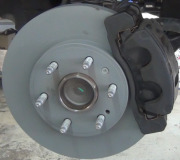Based on my experience, I would have looked at the flex hose right away, and probably would have just replaced it. When I was working on that '70 Coronet, the right-front flex hose actually burst while we were bleeding the system. I ended up replacing all of the flex hoses on principle. They're the weakest point in the system and if any of them show signs of distress, I feel safer replacing all of them (ideally, with braided stainless-steel-jacketed hoses).
Not only that, the idiot who put the thing on didn't install it correctly. He had clipped the the hose into the bracket *before* tightening the fitting on the wheel cylinder so the hose was actually twisted into a full loop between the bracket and the cylinder -- no wonder the thing let go!
I might never have caught on to the rusted bracket constricting the hose. I'm in Florida, so rust is not a problem. My '98 is amazingly free of rust underneath.
The only rust problem I've had was with the water line to the rear heater core, where the rubber line connects to the (expensive!) Stainless-steel line coming from the engine. I discovered it when I had stopped at a tire shop to check prices about a month after I had bought the vehicle (for $1,800, from a dealer, no less!). I'm talking to the clerk, turn around to point out my vehicle in the parking lot, and there it sat with water and steam pouring out from underneath the middle of the vehicle.
Fortunately, I was able to effect a repair by cutting off the rusted end with a tubing cutter and fitting a slightly longer piece of hose.
Now, I need to find a replacement for the spare tire retention mechanism. Discovered that my left rear was low this morning because it had picked up a screw last night, near the edge of the tire where a "plug" repair would be ill-advised. The shop offered to put the spare on for me, but the stupid cable jammed on its spool up inside so that now it won't move either way no matter how much (or in which direction) you crank the nylon nut in the floor. They had to cut a hunk off of one side of the nylon tee off to get the spare out.
It never rains, it pours!
Monday, March 1st, 2010 AT 1:57 PM



